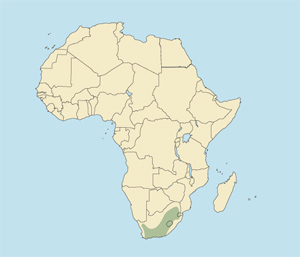 |
Pelea capreolus
Rhebok, Antilope corzo (Sp), Rhebock (G), Rhebuck, Pelea (F), Vaalribbok (Af). Also called gray rhebok. According to Smithers, the common name began as "roebuck"-because this animal reminded the early Europeans who settled in Cape Province of the roe deer of Europe-and changed over the years to "rhebok" in English and ribbok in Afrikaans. "Vaal" means gray (also spelled grey) in Afrikaans, thus vaalribbok in that language. The generic name Pelea is derived from the Tswana phele for this animal, and capreolus is Latin for roebuck.
DESCRIPTION Shoulder height 28-30 inches (71-76 cm). Weight 40-50 pounds (18-23 kg).
The vaal rhebok is a small, graceful antelope with a long, slender neck and a soft, thick, woolly, gray coat. Underparts are white. The end of the nose is very large, rounded and glandular. The ears are long, narrow and pointed. There are no bare, glandular patches below the ears. The tail is short and bushy, white underneath. The horns (males only) are straight, vertical, parallel, ringed in the basal half, and extraordinarily slim for their length. Females are similar to males, but are slightly smaller and without horns.
BEHAVIOR Gregarious, living in family groups of up to a dozen-occasionally as many as 30-usually led by a master male. Young males form bachelor groups, while very old males are often solitary. Males are highly territorial and aggressive, often killing each other during the breeding season. The young (1-2) are usually born November-December. Lifespan in the wild 8-10 years.
Both diurnal and nocturnal. Entirely a grazer. Drinks water daily. Very wary and alert, with a herd member usually acting as sentinel while the others feed or rest. Alarm call is a sharp cough or snort. Eyesight, hearing and sense of smell are excellent. A swift runner and an accomplished leaper, clearing barriers easily. Males are extremely aggressive, being reputed to attack and kill mountain reedbuck and the smaller predators, and even occasionally domestic sheep and goats (but this is disputed). Vaal rhebok are not generally considered edible because of the presence of bot-fly larvae under the skin.
HABITAT Rocky hills, mountain slopes and grassy plateaus. The vaal rhebok utilizes a more open and exposed habitat than the mountain reedbuck. Lives at elevations of 5,500 feet (1,675 m) and higher, but seldom lower.
DISTRIBUTION South Africa and Swaziland, in appropriate habitat. May have occurred in southeastern Botswana at one time, but is not found there now.
REMARKS The vaal rhebok is perhaps the most challenging South African antelope to hunt, a splendid game animal that is not found in all collections. Hunted by glassing and stalking on foot. Difficult to spot, as it blends well with its surroundings, yet it sees very well and, when alarmed, is off with a burst of speed. Shots are often quite long and the target is small. Can be driven at times, especially if there are livestock fences.
The ears are roughly six inches (15 cm) in length; therefore, one should look for horns at least one inch (2.5 cm) longer than the ears.
|





